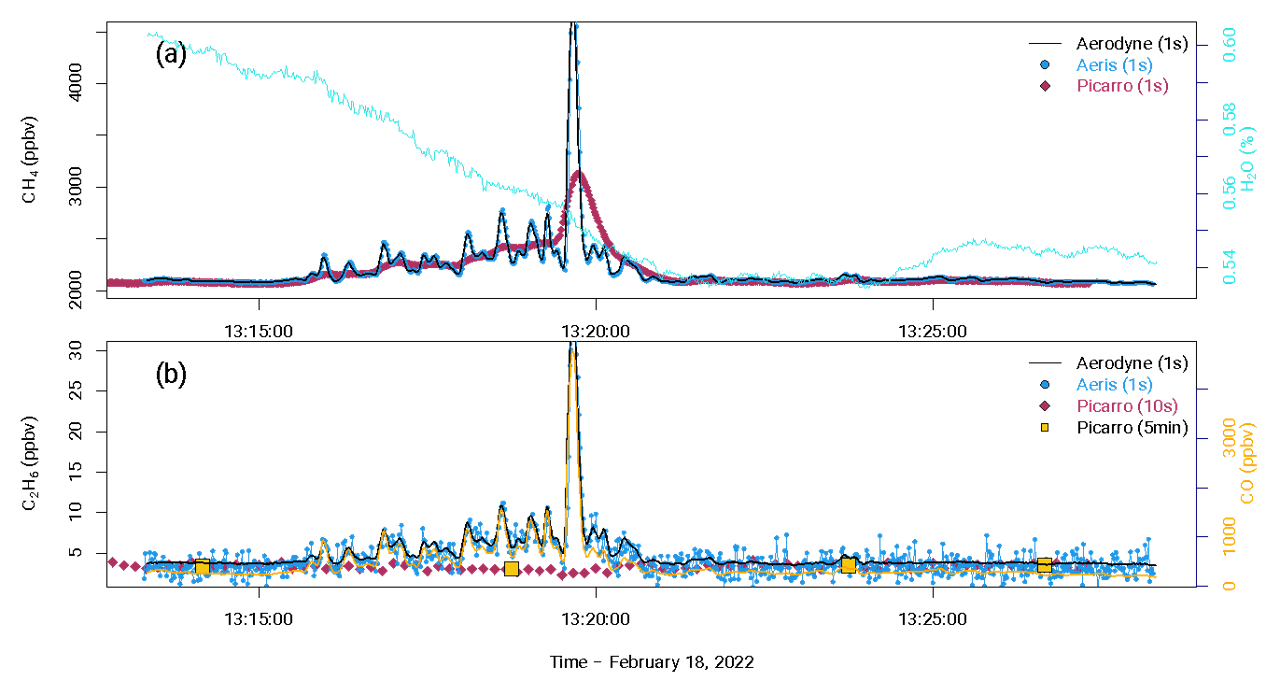
We conducted a comparison of three methane/ethane gas analyzers at our CUNY ASRC field site in February 2022. This comparison tested the stability and precision of an Aerodyne Research Instruments Quantum Cascade Laser/Interband Cascade Laser (ARI SuperDUAL), an Aeris Technologies Ultra CH4/C2H6 (Aeris MIRA Ultra), and a Picarro G2210-i Cavity Ring Down Spectrometer (G2210-i). We recommend the Aerodyne SuperDUAL for its high precision, and the Aeris MIRA Ultra for its low cost and small size.
The ARI QCLS consistently had the highest precision of any of the instruments tested. However, it is the most expensive and requires the most space out of the instruments, so is recommended for cases where high precision is necessary, such as tower deployments or in large mobile deployments. It requires some characterization with respect to water vapor, and regular calibration to account for drift in the instrument Our specific instrument also measures carbon dioxide, carbon monoxide, and nitrous oxide, which were not tested here.
The Aeris Ultra has a small footprint and is the cheapest of the three instruments, making it ideal for small mobile deployments. A similar model lightweight enough to fit on drones (Aeris Pico) is also available. It requires significant characterizations with water vapor, with methane measurements dropping several hundred ppb in a quadratic fashion between 0-2% water vapor. The ethane measurements in this instrument show strange behavior below 1% water vapor, with the instrument detector saturating and not capturing the ethane wavelength and the instrument locking its methane and ethane wavelengths to the water vapor peak. Thus, we recommend that you keep the instrument sampling above 1% water vapor, without running dry tanks through it to calibrate, and discuss potential fixes with the manufacturer.
The Picarro G2210-i methane measurements are stable and precise and do not require as often calibration as the ARI QCLS. However, its ethane measurements are much noiser than the other two instruments (around two orders of magnitude larger noise). This makes the signal to noise ratio at the 1 Hz level too low for quantification at ambient background concentrations of ethane. Additionally, the instrument shows some anticorrelation between methane and ethane, including in the figure provided, when the other two instruments show very high positive correlation, likely due to a natural gas plume. The manufacturer has theorized that this may be a result of interference with the ethane measurement from some other VOC, such as carbon monoxide. Since we observe this issue regularly with this instrument at our urban sampling site, we do not recommend the Picarro G2210-i for urban measurements or ethane measurements near any source of combustion.
- Title
- Intercomparison of commercial analyzers for atmospheric ethane and methane observations
- Authors
- Commane, R., Hallward-Driemeier, A., and Murray, L. T.
- Source
- Atmos. Meas. Tech., 16, 1431–1441, 2023
- Link
- Link
- Title
- Data for: Intercomparison of commercial analyzers for atmospheric ethane and methane observations
- Authors
- Commane, Roisin; Hallward-Driemeier, Andrew
- Source
- Data Dryad, 2023
- Link
- Link